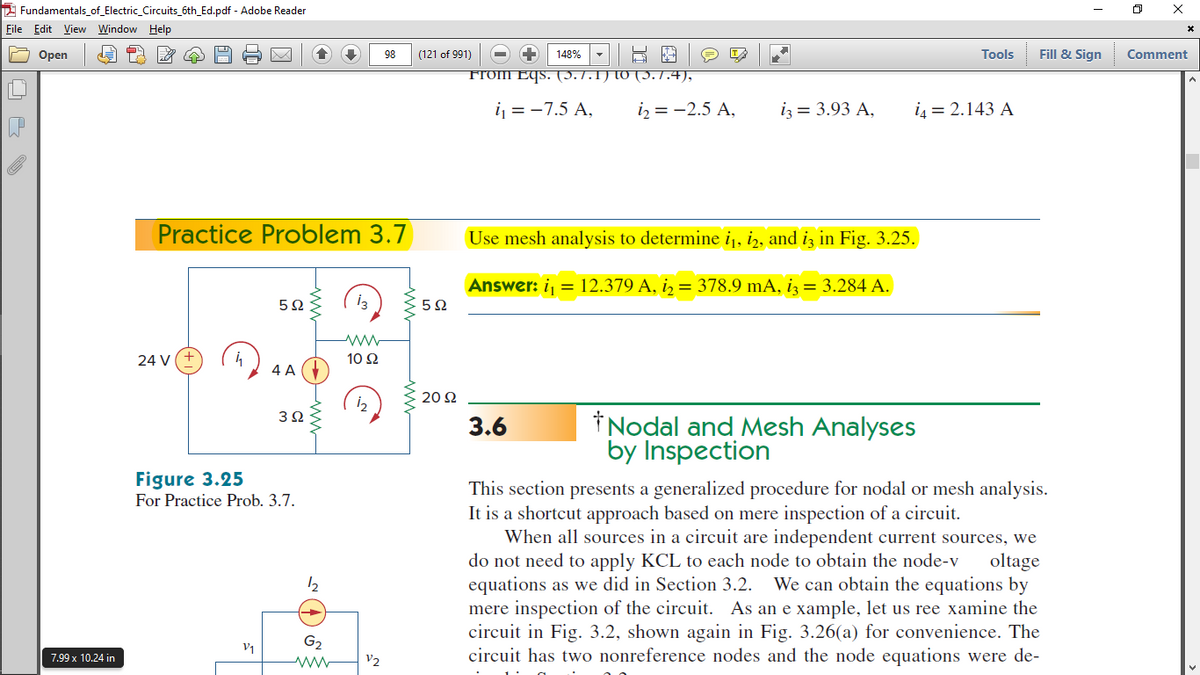Use mesh analysis to determine ij, iz, and iz in Fig. 3.25.
Introductory Circuit Analysis (13th Edition)
13th Edition
ISBN:9780133923605
Author:Robert L. Boylestad
Publisher:Robert L. Boylestad
Chapter1: Introduction
Section: Chapter Questions
Problem 1P: Visit your local library (at school or home) and describe the extent to which it provides literature...
Related questions
Question
What's the solution?

Transcribed Image Text:A Fundamentals_of_Electric_Circuits_6th_Ed.pdf - Adobe Reader
File Edit View Window Help
148% -E E
From Eqs. (3.7.1) to (3.7.4),
Оpen
98
(121 of 991)
Tools
Fill & Sign
Comment
i = -7.5 A,
iz = -2.5 A,
iz = 3.93 A,
i4 = 2.143 A
Practice Problem 3.7
Use mesh analysis to determine i¡, iz, and iz in Fig. 3.25.
Answer: i = 12.379 A, iz = 378.9 mA, iz = 3.284 A.
5Ω
24 V
10 Ω
4 A
20 Ω
İ Nodal and Mesh Analyses
by Inspection
3.6
Figure 3.25
This section presents a generalized procedure for nodal or mesh analysis.
It is a shortcut approach based on mere inspection of a circuit.
When all sources in a circuit are independent current sources, we
do not need to apply KCL to each node to obtain the node-v
equations as we did in Section 3.2.
mere inspection of the circuit. As an e xample, let us ree xamine the
circuit in Fig. 3.2, shown again in Fig. 3.26(a) for convenience. The
circuit has two nonreference nodes and the node equations were de-
For Practice Prob. 3.7.
oltage
We can obtain the equations by
G2
V1
7.99 x 10.24 in
V2
ww
Expert Solution
This question has been solved!
Explore an expertly crafted, step-by-step solution for a thorough understanding of key concepts.
Step by step
Solved in 3 steps

Knowledge Booster
Learn more about
Need a deep-dive on the concept behind this application? Look no further. Learn more about this topic, electrical-engineering and related others by exploring similar questions and additional content below.Recommended textbooks for you

Introductory Circuit Analysis (13th Edition)
Electrical Engineering
ISBN:
9780133923605
Author:
Robert L. Boylestad
Publisher:
PEARSON

Delmar's Standard Textbook Of Electricity
Electrical Engineering
ISBN:
9781337900348
Author:
Stephen L. Herman
Publisher:
Cengage Learning

Programmable Logic Controllers
Electrical Engineering
ISBN:
9780073373843
Author:
Frank D. Petruzella
Publisher:
McGraw-Hill Education

Introductory Circuit Analysis (13th Edition)
Electrical Engineering
ISBN:
9780133923605
Author:
Robert L. Boylestad
Publisher:
PEARSON

Delmar's Standard Textbook Of Electricity
Electrical Engineering
ISBN:
9781337900348
Author:
Stephen L. Herman
Publisher:
Cengage Learning

Programmable Logic Controllers
Electrical Engineering
ISBN:
9780073373843
Author:
Frank D. Petruzella
Publisher:
McGraw-Hill Education

Fundamentals of Electric Circuits
Electrical Engineering
ISBN:
9780078028229
Author:
Charles K Alexander, Matthew Sadiku
Publisher:
McGraw-Hill Education

Electric Circuits. (11th Edition)
Electrical Engineering
ISBN:
9780134746968
Author:
James W. Nilsson, Susan Riedel
Publisher:
PEARSON

Engineering Electromagnetics
Electrical Engineering
ISBN:
9780078028151
Author:
Hayt, William H. (william Hart), Jr, BUCK, John A.
Publisher:
Mcgraw-hill Education,